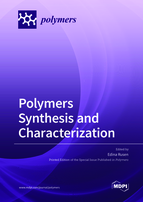Polymers Synthesis and Characterization
A special issue of Polymers (ISSN 2073-4360). This special issue belongs to the section "Polymer Chemistry".
Deadline for manuscript submissions: closed (20 October 2022) | Viewed by 98609
Special Issue Editor
Interests: polymers; nanoparticles
Special Issues, Collections and Topics in MDPI journals
Special Issue Information
Polymer science represents a domain of great interest due to the possible applications of polymers, from the most common to high-tech areas. To achieve this, synthesis and characterization techniques, as well as the correlation of the chemical structure and morphology with their properties, is critical. From the perspective of the synthesis, there are two strategies for obtaining polymers: step-growth (polyaddition, polycondensation, and reversible-deactivation radical polymerization) and chain polymerization (radical polymerization, coordinative polymerization, and cationic and anionic polymerization). Polymer analogous reactions aimed at the control of the hydrophilic-hydrophobic characteristics of the surface or the introduction of responsive moieties onto a polymer backbone are also a very interesting related topic. Surface modification can also be performed using surface-initiated controlled radical polymerization reactions such as atom transfer radical polymerization (ATRP), reversible addition-fragmentation chain transfer (RAFT), nitroxide-mediated living free-radical polymerization (NMP), and iodine transfer polymerization (ITP). Through these methods, polymer grafts and block-copolymers are obtained, displaying different properties than random or alternate polymers obtained by radical copolymerization, which follows the well-known Mayo–Lewis equation. Thus, the physical properties of the polymers can be tailored depending on the structures that are synthesized and on their morphology. The right design that encompasses structure, composition, and morphology is the key to the final applications of polymeric structures.
The advancement of polymer applications continues to generate an expansion of the synthesis and characterization techniques that can be facilitated by novel smart multifunctional polymers. There is a correlation between structure, composition, morphology, and properties of applications that lead to substantial benefits for specific applications.
This Special Issue will establish a collection of articles and reviews that follow the latest developments in polymer synthesis, respectively their characterization techniques and structure-properties correlation.
Dr. Edina RusenGuest Editor
Manuscript Submission Information
Manuscripts should be submitted online at www.mdpi.com by registering and logging in to this website. Once you are registered, click here to go to the submission form. Manuscripts can be submitted until the deadline. All submissions that pass pre-check are peer-reviewed. Accepted papers will be published continuously in the journal (as soon as accepted) and will be listed together on the special issue website. Research articles, review articles as well as short communications are invited. For planned papers, a title and short abstract (about 100 words) can be sent to the Editorial Office for announcement on this website.
Submitted manuscripts should not have been published previously, nor be under consideration for publication elsewhere (except conference proceedings papers). All manuscripts are thoroughly refereed through a single-blind peer-review process. A guide for authors and other relevant information for submission of manuscripts is available on the Instructions for Authors page. Polymers is an international peer-reviewed open access semimonthly journal published by MDPI.
Please visit the Instructions for Authors page before submitting a manuscript. The Article Processing Charge (APC) for publication in this open access journal is 2700 CHF (Swiss Francs). Submitted papers should be well formatted and use good English. Authors may use MDPI's English editing service prior to publication or during author revisions.
Keywords
- polymers synthesis
- polymers characterization
- smart multifunctional polymers
- step-growth polymerization
- chain polymerization
- polymeric structures
- atom transfer radical polymerization (ATRP)
- reversible addition-fragmentation chain transfer (RAFT)
- nitroxide-mediated living free-radical polymerization (NMP)
- iodine transfer polymerization (ITP)







